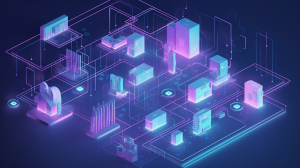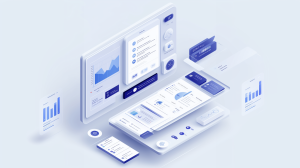This blogpost corresponds to Chapter 2.1 – Fundamentals of CRM in ERP. It is part of Unit 2 – Customer Relationship Management with ERP System of the project training curricula. Moreover, you can check the full structure of the training curricula here. Alternatively, you can learn more about the project by accessing the homepage.
Thus, ERP SW: Introduction to Enterprise Resource Planning (ERP) Software for VET Teachers is a EU-funded project (reference code: 2023-1-DE02-KA210-VET-000150687). Xient GmbH coordinates the project in partnership with L4Y Learning For Youth GmbH and Hadımköy Mesleki ve Teknik Anadolu Lisesi.
To keep up to date, follow us on X, as well as Instagram social media pages. Additionally, you can also follow our follow our YouTube Channel.
Learning Objectives
By the end of this article, ICT VET (Vocational Education and Training) teachers will be able to:
- Understand core concepts of Customer Relationship Management (CRM) within Enterprise Resource Planning (ERP) systems.
- Identify the significance of CRM in modern business operations and its contribution to operational success.
- Explain how CRM modules integrate within ERP systems to centralise data and improve cross-functional collaboration.
- Recognise the key functionalities and features of CRM modules in ERP systems.
- Integrate CRM-ERP principles into their curriculum to enhance the employability of trainees.
- Design real-world projects and assessments that reflect CRM-ERP workflows and analytics tools.
Fundamentals of CRM in ERP: Introduction
As global businesses rapidly adopt integrated software systems, consequently, there’s a growing demand for professionals proficient in ERP (Enterprise Resource Planning) and CRM (Customer Relationship Management). Indeed, these tools streamline business processes, centralise data, and enhance customer satisfaction—key aspects in today’s competitive economy. Therefore, for ICT VET teachers, developing competencies in ERP with embedded CRM modules is critical for training students who will thrive in tomorrow’s workforce.
ERP and CRM are no longer niche solutions limited to large enterprises. Small and medium-sized businesses are also increasingly turning to integrated systems to drive digital transformation. ICT VET instructors are thus at the frontline of equipping learners with knowledge that is not only technical but highly applicable in a range of industries, from retail to logistics to finance.
To that end, this article focuses on equipping VET trainers with the knowledge needed to understand, teach, and implement CRM within ERP frameworks. As a result, by embedding this knowledge in vocational education, institutions can adapt curricula to market needs, thereby improving employability and industry readiness. The article also provides case studies, practical examples, and expert advice to assist educators in designing engaging and future-oriented learning experiences.
Fundamentals of CRM in ERP: Detailed Explanation of Key Points
CRM Concepts and Their Significance in Modern Business Operations
In essence, CRM encompasses strategies, technologies, and practices used by organisations to manage customer interactions throughout their lifecycle. Ultimately, the aim is to improve customer service, boost retention, and drive sales growth (TechTarget, 2024). Consequently, a robust CRM system enables businesses to build long-term relationships with customers by fostering trust, consistency, and responsiveness.
Modern CRM systems centralise customer data gathered through diverse touchpoints—websites, social media, in-person meetings—into one accessible platform. This centralisation allows businesses to personalise interactions, target marketing more precisely, and also deliver timely service responses (SuperOffice, 2023). It also facilitates customer segmentation, allowing organisations to tailor services to specific demographics or behavioural profiles.
In a practical sense, consider a retail company using CRM to track customer purchases and send automated follow-up offers. This tailored experience increases loyalty and lifetime value. Moreover, predictive analytics within CRM can forecast customer behaviour, enabling proactive service (Netsuite, 2023). Companies can anticipate demand, resolve issues before they escalate, and maintain customer satisfaction.
Real-World Insight: Salesforce research indicates that CRM adoption can increase sales by up to 29%, sales productivity by 34%, and also forecast accuracy by 42% (Salesforce, 2023). These improvements demonstrate that CRM is not just a support tool but a strategic driver of performance.
Integration of CRM Modules within ERP Systems
While CRM manages front-end customer relations, ERP focuses on back-end operations like inventory, finance, and HR. Integrating CRM into ERP systems breaks down silos, providing a single source of truth for all departments (AppseConnect, 2023). This alignment leads to a seamless exchange of information across departments, reducing friction and enabling faster service delivery.
This centralisation enables seamless communication between sales, support, and fulfilment teams. For example, when a customer places an order, sales logs it via CRM, inventory updates it in ERP, and finance handles invoicing—all through a unified interface. Customer support agents can also view previous transactions and provide more personalised assistance.
Integration also reduces manual entry errors, accelerates order fulfilment, and improves data accuracy across departments (Focus Softnet, 2023). In sectors like manufacturing and e-commerce, such integration is no longer optional—it’s essential for survival and scalability. In education, this provides an opportunity to simulate end-to-end business processes, helping students understand the flow of data across functions.
Analogy: Think of CRM-ERP integration like a symphony. Each instrument (department) follows the same sheet of music (centralised data), creating harmony in operations. Without that harmony, individual departments may excel in isolation but fail to deliver cohesive customer experiences.
Functionalities and Features of CRM Modules in ERP Systems
CRM modules embedded within ERP systems offer a rich suite of features that streamline both sales and service processes. Below are the core functionalities:
- Contact Management Tracks all customer details, interactions, and communication history. For example, a hotel chain can use CRM to personalise guest experiences by logging preferences and special requests. This functionality also helps manage follow-ups, anniversaries, or loyalty rewards.
- Lead Management Helps businesses capture, track, and nurture leads. A real estate firm, for instance, can monitor buyer interest through various touchpoints, streamlining the sales cycle (Genius ERP, 2023). Educational simulations can be created where students role-play sales cycles from lead generation to closure.
- Interaction Tracking Every email, call, or meeting is documented, enabling a 360-degree customer view. This is invaluable for service teams aiming to resolve issues quickly and contextually. This feature supports transparency and continuity across multiple touchpoints.
- Workflow Automation Automates repetitive tasks like follow-up emails, lead scoring, and scheduling. This increases efficiency and reduces errors (Uway Technology, 2023). Automation also allows team members to focus on high-value activities rather than administrative burdens.
- Analytics and Reporting CRM analytics allow for performance tracking, customer segmentation, and sales forecasting. These insights support smarter decision-making and proactive strategy adjustment. Educators can use built-in analytics tools to teach data interpretation and visualisation.
Stat: According to Oracle, companies using CRM analytics report a 30% improvement in forecast accuracy and a 25% boost in customer satisfaction (Oracle, 2024). These figures underscore the impact of data on customer insights and strategy.
Fundamentals of CRM in ERP: Success Stories and Analogies
Enhanced Customer Experience Case: A retail company integrated CRM with ERP, centralising data to offer personalised promotions based on buying habits. This led to a 20% increase in customer retention.
Analogy: Like a personal shopper who knows your style and budget, CRM in ERP anticipates customer needs and delivers value. The result is a frictionless, rewarding experience that feels custom-built for each customer.
- Operational Efficiency Case: A manufacturing firm automated sales and service workflows through ERP-integrated CRM. Manual errors fell by 30%, and productivity rose by 25%.
Analogy: Picture a well-tuned orchestra. When every department plays in sync, the result is flawless performance. Coordination and communication become second nature, leading to faster deliveries and happier clients.
- Data-Driven Decision Making Case: A financial services provider used CRM analytics to discover patterns in client behaviour. They adjusted campaigns accordingly, achieving a 15% rise in new customer acquisitions.
Analogy: CRM analytics serve as a GPS for strategic planning—pointing your business towards customer satisfaction and growth. Just as GPS helps you avoid traffic and choose the best route, analytics inform where to focus resources and attention.
Resources for Learning
Here are curated resources to help ICT VET trainers build their CRM-ERP knowledge:
- Course: CRM & ERP Integration Basics (Coursera)
- Whitepaper: The Future of ERP-CRM Integration (Oracle)
- Case Studies: CRM Integration in Action (Ginesys)
- Video Tutorial: CRM Features in ERP (Netsuite)
- Tool Demo: Salesforce CRM Demo
- Textbook: Principles of ERP and CRM Systems for Education
- Online Forum: ERP Teachers’ Collaborative Network (LinkedIn)
Expert Advice
“ERP and CRM integration is not just about tools; it’s about creating a connected experience for both your teams and your customers.” — Vikram K, Tech Consultant (LinkedIn, 2023)
“A unified system enables customer-facing teams to act faster, serve better, and sell smarter.” — Ginesys Blog (Ginesys, 2023)
“CRM modules today are the nervous system of modern ERP—real-time data, real-time decisions.” — Uway Technology (LinkedIn, 2023)
“Vocational training that includes CRM-ERP integration reflects the real-world digital environments our graduates will work in.” — Dr. Anya Schultz, ERP Education Specialist (EduTech Europe, 2024)
These insights reinforce the necessity of integrating CRM training into VET curricula to prepare students for evolving digital workplaces. Teachers should use this advice to continually refine their instructional approaches and align with industry trends.
Conclusion and Call to Action
ICT VET teachers play a pivotal role in shaping the next generation of ERP professionals. Understanding CRM within ERP systems equips trainers to build relevant, future-ready curricula that mirror real-world demands.
To stay ahead, educators must:
- Incorporate CRM-ERP integration into course modules.
- Provide hands-on training using real CRM-ERP platforms.
- Partner with businesses for practical insights and internships.
- Encourage critical thinking and creative problem-solving using CRM case studies.
- Offer certification opportunities through CRM-ERP software providers.
Now is the time to elevate vocational training. By embracing the fundamentals of CRM in ERP, we don’t just teach software—we empower a digitally literate workforce ready to thrive. The transformation of vocational education lies not just in what is taught, but in how closely it aligns with the digital realities of the workforce.
By fostering a mindset of integration, collaboration, and data fluency, ICT VET teachers become catalysts for a new generation of professionals who can navigate, adapt to, and lead in increasingly complex digital environments.







